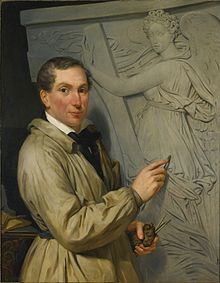Charles-René Laitié
Charles-René Laitié | |
|---|---|
 Portrait of Charles-René Laitié sculpting la Force c. 1824 | |
| Born | 1782 Paris, France |
| Died | 11 December 1862 Paris, France |
| Nationality | French |
| Occupation | Sculptor |
Charles-René Laitié (1782 – 11 December 1862) was a French sculptor.
Early years
Charles-René Laitié was born in Paris in 1782. He became a pupil of Claude Dejoux (1732–1816).[1] He also studied under Pierre Cartellier.[2] He won a medal from the Royal School in the year XII, and the Grand Prix de Rome in 1804.[1] The prize was awarded for his Méléagre refusant son secours aux habitans de Calydon.[2] While in Rome in 1806 Laitié made a plaster model of Homer. In 1827 he presented a small bronze at the Salon from this model, with the date 1806.[3]
Bourbon Restoration
In 1820 Laitié was commissioned by the state to make a statue of Jean de La Fontaine, the poet. It was exhibited in the salon in 1822 and installed in Château-Thierry on 6 November 1824.[4] He won a gold medal at the Salon of 1824.[1] The sculptor Claude André Deseine had made a large sculpture of General Colbert during the First French Empire. Under
In 1830 Laitié made the central figure of Charity for the portico of Notre-Dame-de-Lorette, Paris. It is flanked by Faith by
Works

Laitié's works include:[1]
- 1812 Bust of Man (marble)
- 1814 Bust of the king
- 1817 Astronomer, bas-relief intended for the fountain of the Bastille.
- 1819 St. John the Baptist
- 1822 marble bust of Nicolas-Pierre Tiolier, engraver-general of currencies
- 1822 Statue of Jean de La Fontaine, marble, 6 ft high, for the town of Château-Thierry
- 1822 St. Luke, stone statue, 12 ft high for Arras Cathedral
- 1824 Charity plaster group for the church of Saint-Étienne-du-Mont
- 1824 Stone bas-relief stone for the center of the courtyard of the Louvre, representing Justice and Strength[7]
- 1824 Bust of Mme Tiolier
- 1827 Homer plaster statue 5 ft 9 inches.
- Relief for the ceiling of the staircase of the Paris Bourse, representing Themis and Mercury
- 1825 Marble bas relief, representing Painting placed in the grand staircase of the Museum, 6 ft, included in the exhibition of 1827
References
- ^ a b c d Gabet 1831.
- ^ a b Comte de Clarac 1847, p. 447JJ.
- ^ Lapaire 2011.
- ^ Base Palissy: Statue : Jean de La Fontaine, Ministère français de la Culture. (in French)
- ^ Base Palissy: Statue (figure colossale) : le maréchal Mortier, Ministère français de la Culture. (in French)
- ^ Présentation de l'Église, Notre-Dame-de-Lorette.
- ^ La Justice et la Force... Louvre.
Sources
- Comte de Clarac (1847). Manuel de l'histoire de l'art chez les anciens [ed. by V.Texier]. Retrieved 2014-08-21.
- Gabet, Charles (1831). "LAITIE (Charles-Rene)". Dictionnaire des artistes de l'école française au XIXe siècle: Peinture, sculpture, architecture, gravure, dessin, lithographie et composition musicale. Madame Vergne. Retrieved 2014-08-21.
- "La Justice et la Force. Charles René Laitié. 1824". Le décor extérieur du Louvre. Retrieved 2014-08-21.
- Lapaire, Clause (2011-04-25). "La genèse d'une sculpture de James Pradier : Homère et son guide". Forum Pradier. Retrieved 2014-08-21.
- "Présentation de l'Église". Notre-Dame-de-Lorette. Archived from the original on 2014-08-26. Retrieved 2014-08-21.
